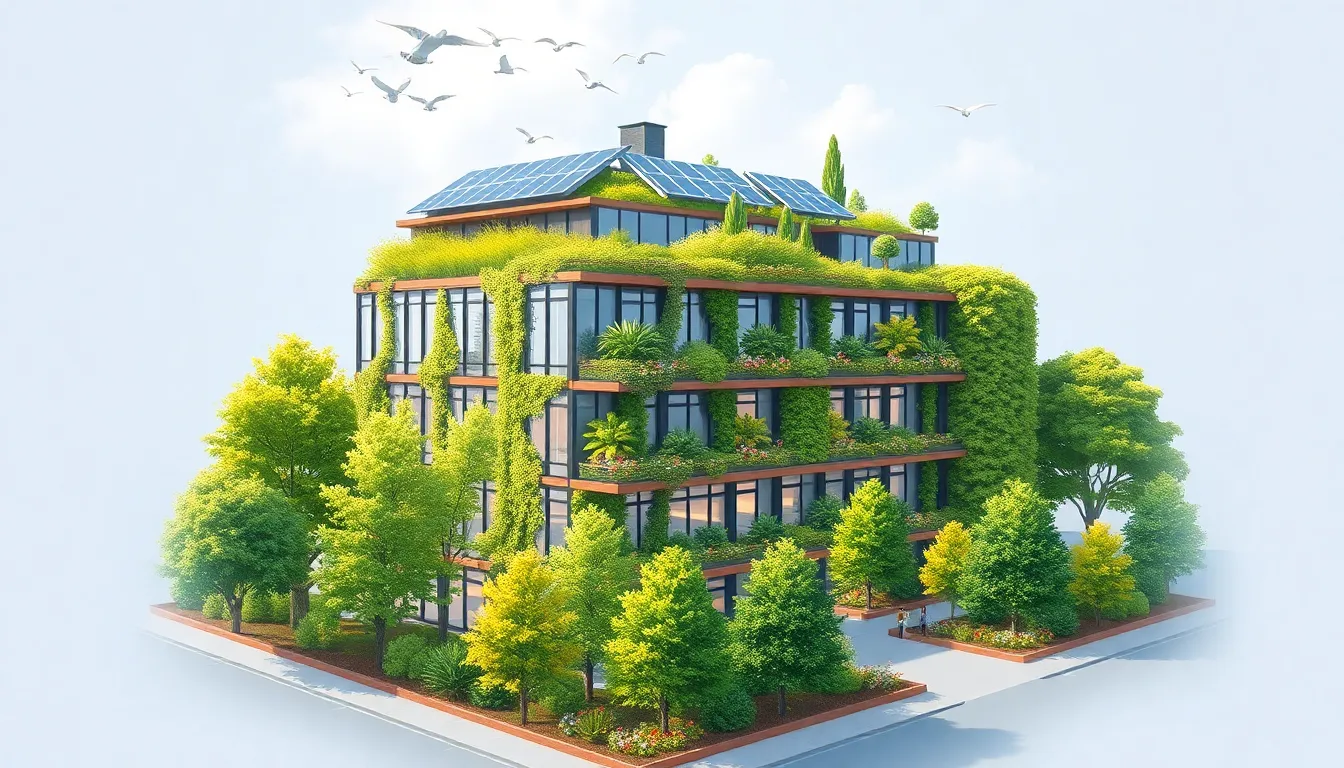In a world where the planet’s health hangs by a thread, sustainable building technology emerges as the superhero we didn’t know we needed. Imagine structures that not only shelter you but also hug trees, recycle rainwater, and even generate their own energy. It sounds like a scene from a sci-fi movie, but it’s happening right now, and it’s time to take notice.
Gone are the days when buildings were just concrete boxes. Today’s architects and builders are crafting eco-friendly marvels that blend innovation with sustainability. They’re turning the construction industry on its head while saving the planet one green roof at a time. If you think building sustainably is all about sacrificing style, think again. Join the revolution and discover how these technologies can transform not just buildings but also the way we live and interact with our environment.
Table of Contents
ToggleOverview of Sustainable Building Technology
Sustainable building technology focuses on minimizing environmental impact through the use of innovative practices and materials. These advancements aim to establish structures that integrate seamlessly with their surroundings while promoting energy efficiency. Modern architects and builders employ techniques such as passive solar design and smart building systems to optimize functionality.
Energy generation through renewable sources remains a fundamental aspect of sustainable buildings. Solar panels and wind turbines provide significant power and contribute to energy independence. Water conservation practices also play a critical role, with systems designed for rainwater harvesting and greywater recycling.
Materials selection is key in sustainable construction. Recycled, reclaimed, and regionally sourced materials reduce resource depletion while promoting local economies. Insulation techniques using natural fibers, such as wool or hemp, enhance energy efficiency while maintaining indoor air quality.
Incorporating green roofs and living walls benefits both aesthetics and biodiversity. These features support urban wildlife while regulating building temperatures, thus reducing heating and cooling costs. Overall, the aim is to create a harmonious balance between human habitation and nature.
Sustainable building technology continually evolves, driven by innovations and advancements in research. Developers and stakeholders embrace tools like Building Information Modeling (BIM) to enhance design accuracy and sustainability assessments. Adopting these technologies fosters resilience against climate change and prepares communities for a sustainable future.
Benefits of Sustainable Building Technology

Sustainable building technology offers numerous advantages that impact the environment and economy positively.
Environmental Impact
Sustainable building technology significantly reduces carbon footprints. Structures designed with sustainability in mind utilize energy-efficient systems and renewable resources, lowering reliance on fossil fuels. Eco-friendly materials promote habitat preservation and enhance biodiversity. Water conservation methods like rainwater harvesting reduce strain on local water supplies. By incorporating green roofs and living walls, buildings improve air quality while providing natural insulation. These features contribute to better stormwater management, reducing flooding risks. Overall, the implementation of these technologies fosters healthier ecosystems and communities.
Economic Advantages
Economic benefits accompany sustainable building technology through cost savings and increased property values. Energy-efficient designs lower utility bills and operational costs, enhancing returns on investment. Many municipalities offer incentives and tax breaks for sustainable construction, reducing initial costs. Additionally, property values for green buildings often exceed those of traditional buildings due to growing demand. Investing in resilient designs prepares properties for climate-related challenges, safeguarding financial interests. As awareness surrounding sustainability continues to rise, these advantages will become increasingly significant for developers and homeowners alike.
Key Components of Sustainable Building Technology
Sustainable building technology integrates various elements aimed at enhancing environmental performance and promoting efficiency. Key components include renewable energy sources and sustainable materials.
Renewable Energy Sources
Solar panels capture sunlight and convert it into usable energy, reducing reliance on fossil fuels. Wind turbines harness wind power, providing another clean energy alternative. Geothermal systems tap into the Earth’s temperature for heating and cooling, further promoting energy independence. These energy sources not only lower operational costs but also minimize greenhouse gas emissions. Significant investments in renewable technologies lead to long-term savings and enhanced energy security. Incentives for using these systems encourage broader adoption among builders and homeowners.
Sustainable Materials
Sustainable materials, like recycled steel and reclaimed wood, significantly reduce environmental impact. Their usage supports resource conservation and minimizes waste. Products sourced locally lower transportation emissions and bolster regional economies. Natural fiber insulation enhances energy efficiency while improving indoor air quality. Green roofs constructed with native plants help manage stormwater and foster biodiversity. Each material choice reflects a commitment to reducing the carbon footprint of buildings, paving the way for eco-friendly construction practices.
Innovations in Sustainable Building Technology
Innovations continue to shape sustainable building technology, emphasizing efficiency and environmental harmony. Modern solutions focus on optimizing resource use and minimizing ecological impact.
Smart Building Systems
Smart building systems use advanced technologies to enhance energy efficiency and user comfort. These automated systems track energy consumption in real-time, adjusting heating, cooling, and lighting based on occupancy and weather conditions. Sensors play a crucial role, enabling responsive environments that conserve energy and reduce costs. Implementing smart technology can lower utility bills by 30 percent or more, significantly benefiting long-term sustainability goals. Integration with renewable energy sources like solar panels amplifies environmental advantages. Enhanced monitoring provides insights, driving continuous improvement in energy management.
Green Roofs and Walls
Green roofs and walls provide both aesthetic and environmental benefits. These living structures support biodiversity by creating habitats for various species, including birds and insects. Vegetation improves insulation, reducing the building’s energy demand for heating and cooling. Studies show that green roofs can lower indoor temperatures by up to 10 degrees Fahrenheit, enhancing comfort while minimizing reliance on mechanical systems. Additionally, these installations manage stormwater efficiently, reducing runoff and mitigating urban flooding risks. They also improve air quality by filtering pollutants, contributing to healthier urban environments.
Challenges in Implementing Sustainable Building Technology
Adoption of sustainable building technology faces several key challenges. Initial costs of eco-friendly materials and systems often deter builders and developers. These expenses include advanced insulation, renewable energy installations, and water recycling systems. Budget constraints limit many projects from pursuing sustainable options, even when the long-term savings can be significant.
Market demand also plays a role in the challenges faced. When clients prioritize immediate cost savings, decision-makers might overlook the benefits of investing in sustainable practices. Furthermore, lack of awareness regarding the advantages of eco-friendly construction can lead professionals to undervalue sustainability. Education and training are crucial in shifting perspectives within the industry.
Regulatory hurdles pose additional difficulties. Building codes and zoning regulations may not always accommodate innovative sustainable practices or materials. Navigating these regulations often requires additional time and resources. Local governments may benefit from updating policies to promote sustainable technology and practices.
Integration of new technologies presents challenges in itself. Existing structures might not easily adapt to smart building systems or energy-efficient designs. Moreover, training staff and contractors on utilizing these new technologies can lead to temporary disruptions during the learning phase.
Finally, supply chain issues can hinder access to sustainable materials. Regional scarcity of reclaimed wood, for instance, limits options for builders committed to eco-friendliness. Ensuring a reliable flow of sustainable resources remains a challenge as demand continues to grow. Sustainable building technology, despite its advantages, encounters these obstacles that require collaborative solutions from industry stakeholders.
Future Trends in Sustainable Building Technology
Innovations in sustainable building technology continually reshape the construction landscape. Increased integration of smart technology enhances building efficiency and user experience. Advanced materials emerge, focusing on carbon reduction and energy efficiency.
Passive solar design techniques gain prominence, maximizing natural light and minimizing heating needs. Emerging materials such as transparent solar panels allow for energy generation without compromising aesthetics. Adoption of 3D printing methods reduces waste and promotes rapid construction, enabling flexibility in design.
Energy storage solutions advance, making renewable energy utilization more practical. Battery technologies evolve, allowing buildings to store excess energy for use during peak demand. Urban planning incorporates green infrastructure strategies, such as enhanced green roofs and eco-friendly urban forests, contributing to better air quality and biodiversity.
Collaboration among architects, builders, and technology providers fosters innovative solutions. Open-source design platforms encourage the sharing of sustainable practices, making cutting-edge technologies accessible to a wider audience. Education initiatives expand, raising awareness about sustainable practices among industry professionals and consumers alike.
Legislation increasingly supports sustainable practices, offering incentives for energy-efficient designs and renewable installations. These regulatory changes drive the adoption of sustainable technologies while promoting responsible resource management.
Feedback loops from existing projects enhance design methodologies, leading to continuous improvement and greater efficiency. Market demand for sustainable buildings surges, with consumers valuing eco-friendly options. Appraisers now consider energy-efficient features in property evaluations, reflecting their growing importance in real estate.
Future developments in sustainable building technology promise to create resilient, efficient environments that coexist harmoniously with nature.
Sustainable building technology is reshaping the construction landscape by prioritizing environmental integrity and energy efficiency. As innovations continue to emerge, the integration of smart systems and renewable energy sources becomes increasingly vital. This shift not only enhances the aesthetic and functional aspects of buildings but also supports a healthier planet.
The growing demand for sustainable practices is driving collaboration among industry professionals, fostering a culture of innovation. By embracing eco-friendly materials and advanced techniques, the construction sector can effectively address the challenges of climate change. The future of sustainable building technology holds immense potential for creating resilient spaces that harmonize with nature, ensuring a better quality of life for generations to come.
